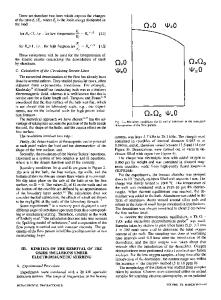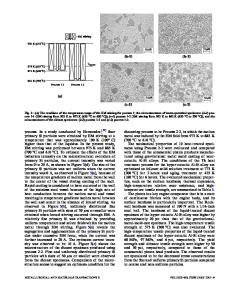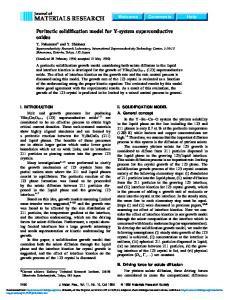An In-Situ Diagnostic Study of Electromagnetic Stirring Effects on Peritectic Solidification Kinetics for Containerlessl
- PDF / 8,634,685 Bytes
- 15 Pages / 593.972 x 792 pts Page_size
- 102 Downloads / 294 Views
echnologically important materials, such as iron-based alloys, titanium-based alloys, copper-based alloys, nickel-based alloys and aluminum-based alloys, belong to peritectic alloy systems.[1–6] In the process of melt cooling, these peritectic alloys usually exhibit typical peritectic reaction, i.e., primary solid phase (a) reacts with the remaining liquid (L) to form a second solid phase (b).[5,6] The properties of peritectic alloys are closely related to the corresponding solidification processes.[7–9] A fundamental understanding of peritectic solidification kinetics is highly desirable because it plays an important role in the technological advances. Owing
Y. H. WU, J. CHANG, L. HU, S. SHA, X. CAI, S. S. XU, and B. WEI are with the Department of Applied Physics, Northwestern Polytechnical University, No. 127 of West Youyi Road, Xi’an, 710072, Shannxi Province, P.R. China. Contact e-mail: [email protected] Manuscript submitted September 21, 2019.
METALLURGICAL AND MATERIALS TRANSACTIONS A
to scientific interests and practical applications, peritectic solidification behavior has been an active research topic in the past decade.[10–14] Furthermore, extensive experimental and theoretical investigations have been performed to understand solidification behaviors of peritectic alloys.[12–17] Nevertheless, most of previous investigations mainly focused on the solidification mechanism selections, microstructure characteristics modulations and mechanical property optimizations. So far, the attention to peritectic solidification kinetics is rather limited especially at extremely non-equilibrium solidification conditions due to the experimental difficulty in conducting an in-situ observation.[18] Thus, much work still needs to be done to get a better understanding of peritectic solidification kinetics. Fortunately, with the help of undercooling techniques,[18–23] liquid peritectic alloys achieve non-equilibrium solidification in a relatively slow cooling process. This makes it possible to investigate the peritectic solidification process when the in-situ diagnostic techniques are employed simultaneously. In recent years, using containerless processing techniques of electrostatic
levitation (ESL),[18–20] electromagnetic levitation (EML),[21,22] aerodynamic levitation[23] and acoustic levitation[24] assisted with a high-speed photodiode and a high-speed camera, the undercooling dependence of primary dendrite growth velocity has been measured for various peritectic alloys, and the primary dendrite growth kinetics can be determined accordingly.[14,19] As it is very difficult to obtain the substantial undercoolings, primary dendrite growth kinetics in supercooled states has scarcely been reported. As we all known, the peritectic solidification process involves not only the primary dendrite growth but also the subsequent peritectic reaction. At present, conducting an in-situ study for the measurements of peritectic reaction time and peritectic reaction intensity is still difficult in undercooled state. Up to now, little attentions have been pai
Data Loading...









